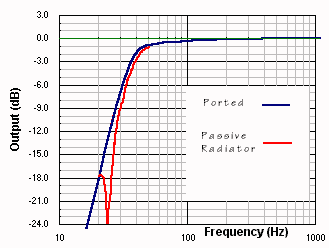|
|
Passive radiator systems are very
similar in operation to ported systems. However, instead of a port, the passive radiator
system uses a passive radiator (also known as a "drone cone") to extend the
system's low frequency response. The response of a passive radiator system is similar to that of a ported system using the same driver. However, the cutoff (-3dB) frequency is slightly higher, and the cutoff slope is deeper, mostly due to the presence of a "notch" in the frequency response corresponding to the passive radiator's resonance frequency. However, this notch is normally located far outside of the passband of the system, and therefore usually of little audible significance. The larger the passive radiator, the lower the passive radiator's resonance frequency (for the same target Fb), and the further the notch is out of the passband.
To design a passive radiator alignment, start with a simple ported alignment using that driver that provides the desired box size and frequency response. Then, use the diameter of your chosen passive radiator as the "port diameter", and use this to calculate the required port length. Work out the volume occupied by this port and then use this to calculate the mass of air occupied by this port. The result is the required mass of the passive radiator. If it is too small, use a larger passive radiator and repeat the calculations. Example: Driver: Ported Alignment (QB3): Note that the effective diameter of the radiator is approximately equivalent to the diameter of the passive radiator's face plus 1/3 of the surround. If unsure, use the quoted Sd for that radiator, then use the following equation to determine the effective radius: R = (Sd/PI)^0.5 In this case, we choose to use a passive radiator that has an effective
radius of 5 inches (roughly corresponding to a "12-inch" passive
radiator). "Port" Volume = (PI*R^2)*h Mass = "Port" Volume * Density of Air The passive radiator therefore has to have a weight of 290g. To achieve this, start with a passive radiator with lower mass, then add weight to make up the difference. To measure the resonance frequency of the passive radiator, install it in a free-air baffle (e.g. the box it's going in, without the driver in place), then hold a driver, driven by a sine wave generator, as close as possible to the passive radiator, then vary the frequency. At the passive radiator's resonance frequency, you should see the greatest peak to peak excursion of the passive radiator. Like their ported cousins, passive radiator systems are much more sensitive to misaligned parameters than sealed enclosure systems, which makes their construction more difficult for the beginning DIYer. I advise that you don't attempt to build these systems, unless you're certain that the T/S parameters for the driver that you want to use are correct. Almost any driver can be used in a passive enclosure system, however, only drivers which have a Qts value between 0.2 to 0.5 will generally give satisfactory results. If the driver has a Qts above 0.4, try using it in a sealed enclosure or single reflex bandpass system instead. Passive Radiator System projects on the internet:
|

